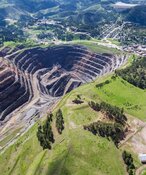The Gold Report: After flirting with $1,300 per ounce ($1,300/oz) in January, gold has fallen to around $1,200/oz. What happened?
Olivier Tielens: Deflationary forces are still leading the game. There's a 50% chance that we may go to a new low, very probably the final bottom, and a 50% chance gold will trade throughout 2015 in a tight range.
TGR: A few years ago, gold rose tremendously after the U.S. Federal Reserve began quantitative easing (QE). Since then, further rounds of QE from the Fed and, more recently, massive QE from Japan and the European Union have not buoyed the price of gold. Why not?
OT: QE is not working. Europe is in a depression. The velocity of money continues to decrease and is now lower than for decades. People are hoarding cash, and that's deflationary. Zero and even negative interest rates continue, and that could help gold because even though gold doesn't pay interest, at least bullion owners aren't losing money by holding it.
Inflation will arrive after confidence in the central banks fades. Investors will then want out of the U.S. dollar and into gold. When will that happen? Nobody knows, but it always comes like a thief in the night. Or we could have another black swan event, but this is less likely than in 2008 because the powers that be have learned from that, and there is now so much liquidity in the system.
TGR: QE and zero interest rates are not helping gold, but they are highly correlated to growth in the broader equity markets, with the S&P 500 continuing to hit record highs. How long can this last?
OT: I can see the Dow Jones hitting 30,000. All that liquidity has to find a home. So I'm bullish on the broader equities.
TGR: So, if we haven't yet seen a bottom for gold bullion, would the same hold for gold equities?
OT: They go hand in hand. I told people at the Vancouver Resource Investment Conference last month that, despite the general bullishness, I was not particularly impressed by the equity gains following the end of tax-loss selling in December. One of the best leading indicators of the last 14 years since the bull market started was that a rise in shares always preceded a rise in bullion. So, if we had reached the bottom, gold producers should have realized much bigger share increases.
That said, the price of gold has increased. And the margins of the gold producers are rising for two reasons. First, the price of oil has been cut in half. Second, pretty much every currency has fallen against the U.S. dollar, and most of the world's gold is produced outside the U.S.
TGR: The gold-silver price ratio, which had been at around 65 for several years, recently advanced toward 80. It has now declined to about 71. What are the prospects for silver, and how will the gold-silver ratio change?
OT: I'm bullish on silver. Of course, most of those who are bullish on gold are bullish on all precious metals. But I think we are heading toward a bubble phase in gold, and when gold becomes too expensive, investors will buy silver instead.
Another reason to be bullish on silver is that it is both a monetary metal and an industrial metal. About 55–60% of silver is bought for industrial use. And industrial demand is pretty inelastic because the cost of silver in products is such a small part of total production costs.
Growth in the demand is to be expected in some segments of silver as an industrial metal, so the ratio of 55% of silver going to industrial applications will go on for the foreseeable future, which then doesn't leave too much for when investment demand comes back.
TGR: It has been the received wisdom for several years that institutional investors are not interested in gold and silver. Has this changed?
OT: I co-organized a gold conference in Brussels this month for the Belgian Federation of Financial Analysts. Allocation managers and chief economists of banks and brokerage houses were invited. James Turk of GoldMoney came from London. We had people that actually control a lot of money. In Europe, 99% of investors have never been in gold; they don't understand it. We got good feedback from the conference, as well as several interviews in the major business and financial magazines.
Since then, many banks have said they'll put gold on the agenda for their next allocations. I will be meeting with several chief economists and bank CEOs in the next few weeks. They want to know more, and I want them to be prepared for gold's next bull run. Gold needs buyers at $1,200/oz, at $1,600/oz and again at $2,000/oz. In the long term, I think gold will end up much higher than that.
TGR: So the European money men are no longer so bullion-averse, but what about gold equities?
OT: I think we'll need to wait for the next bull run in gold equities for European investors to show much interest beyond the usual suspects. The mainstream financiers I talk to will have one or two majors and one or two royalty companies, usually Franco-Nevada Corp. (FNV:TSX; FNV:NYSE) and Silver Wheaton Corp. (SLW:TSX; SLW:NYSE).
Canadian financiers are different. You see it in the coverage. Most of the producers have coverage from each and every Canadian bank and Canadian brokerage house. In Europe, coverage is restricted to 5–10 precious metals stocks, and that's because of demand from some clients. European investors live in a big cocoon, but that will change when gold goes mainstream.
TGR: I notice that several of the companies you follow are project generators. What do you like about that model?
OT: It's a matter of risk versus reward. The project generators have joint-venture (JV) partners that spend the money and do the heavy lifting of advancing projects. Risk is thus spread over several potential discoveries and in some cases over several mining jurisdictions. Most project generators have cash, as well as tight share structures, which means they can raise money without too much dilution.
TGR: Which project generators are your favorites?
OT: Midland Exploration Inc. (MD:TSX.V), Strategic Metals Ltd. (SMD:TSX.V) and Riverside Resources Inc. (RRI:TSX.V).
I'll start with Midland. This is a well-run company with cash, access to cash and, even in this market, 10 active JVs, which is remarkable. Midland has big partners, like Teck Resources Ltd. (TCK:TSX; TCK:NYSE) and Agnico Eagle Mines Ltd. (AEM:TSX; AEM:NYSE). It is operating in Quebec, a good jurisdiction, with proven people and with 10,000 meters (10km) of drilling scheduled for this year, which is, of course, paid for with other people's money. Midland has good exposure to discovery.
TGR: What do you like about Strategic?
OT: This company has pretty much the most experienced team in the Yukon. This is a very nice risk-reward situation as Strategic's market cap is slightly less than its cash in hand. The company also has interests in several spinoffs that have good potential, companies such as ATAC Resources Ltd. (ATC:TSX.V), Rockhaven Resources Ltd. (RK:TSX.V) and Silver Range Resources Ltd. (SNG:TSX.V).
All three of those companies have discoveries, and Strategic has the cash to keep its stakes when those three raise money. This is not a tenbagger situation tomorrow as they're not yet producing at today's low prices, but when the market comes back, there will be a lot of value in the projects Strategic will keep, the projects it will JV with other companies and its spinoffs.
TGR: What do you like about Riverside?
OT: Riverside has three company-owned gold and silver projects in Mexico, and four JV projects there. It has strategic alliances with Antofagasta Plc (ANTO:LSE) and Hochschild Mining Plc (HOC:LSE). It's a well-run company with a good share structure and cash in the bank. It's probably a little less active than Strategic and Midland, but again it's a nice risk-reward situation with good potential for discoveries and exposure to higher gold and silver prices.
TGR: Riverside Resources is in Mexico, as are many of the companies you follow. What makes Mexico a good jurisdiction?
OT: Mexico has historic core strengths in mining. It has the resources: the gold and the silver. And it has the people, the investment, the infrastructure and the expertise. Seven or eight years ago, there were over 200 Canadian juniors active in Mexico. We are seeing less activity than before because of the new royalty regime, but this is a global problem. When governments want more revenue, they go after the mining companies. We've seen this most recently with Guatemala and Zambia.
TGR: Let's talk more about jurisdictions. What's your philosophy in this regard?
OT: We look to spread country risk. We like Canada first, then the U.S. and then parts of Europe. As a European, I have fewer problems with Africa than Canadians do. Many Canadians would never consider investing in companies that operate in Africa, and that is not the wisest course. Some countries there have risk no higher than in Central or South America.
For all the talk of the coup in Mali, there's never been a gold mine there that has stopped producing for even one day. Mali gets 20% of its revenue from mining, and the plan is to raise that over the next decade to 40%. I think Mali is back on track.
I'm more cautious about Burkina Faso because unlike Mali, which has two centrist parties, Burkina Faso is threatened by the rise of extreme leftists. Should they come to power, we're likely to see a new mining code or much bigger royalties. We could end up with mining suffering for several years before the new regulations are reversed. This sort of thing is always happening in Africa.
TGR: Returning to Mexico, which is your favorite gold producer there?
OT: We're long-term supporters of Timmins Gold Corp. (TMM:TSX; TGD:NYSE.MKT), which announced record production for 2014: 122,000 oz (122 Koz) gold equivalent. In December, the company bought Caballo Blanco from Goldgroup Mining Inc. (GGA:TSX). That was a smart move. If Timmins can get that permitted, say in the next year, that would add production of 90 Koz per year. In addition, Timmins has recently announced good discoveries on its land adjacent to its San Francisco mine: 1.29 grams per ton (1.29 g/t) gold over 33.9 meters (33.9m), 5.52 g/t over 10.2m and 8 g/t over 14m.
So Timmins looks to be able to increase production and reserves, while lowering cash costs. This will have a double effect on its bottom line. As suggested above, the company has much exploration potential on these two properties because little of it has been explored. It has eight other properties in its portfolio, which results in a pipeline of years of organic growth. And this is a company that has proved it can deliver. Timmins Gold's all-in cash cost guidance for 2015 is $800–850/oz.
Timmins announced very recently that it would take over Newstrike Capital Inc. (NES:TSX.V), which gives it a superb pipeline if the deal gets confirmed. Indeed, with Newstrike's Ana Paula project, Timmins can add substantial production at even lower cost than what it produces at today. Clearly for us it is a winner down the road, led by a superb team that managed to go into production in 2009, just after the financial crisis, and so far only has had quarters with positive cash flow.
TGR: What's your favorite silver producer in Mexico?
OT: Great Panther Silver Ltd. (GPR:TSX; GPL:NYSE.MKT) is a good silver producer with growth. Its recent discoveries at San Ignacio are amazing, including 5 g/t gold and 194 g/t silver over 13.8m announced Jan. 27. It's no wonder Great Panther is looking to acquire other projects or companies. Should it do so, we have no doubt that it would succeed with them. Great Panther is producing silver at about $16–17/oz. That's sharp, but it will come down, especially as it ramps up San Ignacio. This is a company that finds solutions to its problems.
TGR: Which precious metals explorers do you follow in Mexico?
OT: The gold explorer I like is Minaurum Gold Inc. (MGG:TSX.V). The advantage of explorers is that, of course, their share prices do not simply rise and fall with prices of gold and silver. In a sideways market, as we have today, the biggest value can be created with good drill holes.
Minaurum is a company with solid management and a great deal of experience in Mexico. CEO Darrell Rader worked with IMPACT Silver Corp. (IPT:TSX.V) and Energold Drilling Corp. (EGD:TSX.V). The company has on its board Peter Megaw and David Jones, two of the country's most successful geologists. Jones is, in fact, known as "Mr. Guerrero Gold Belt." Minaurum has four great properties, one of which is optioned to Lowell Copper Ltd. (JDL:TSX.V). It's been a bit of a waiting game for the last year, but the company is making headway now.
TGR: Do you like the Guerrero Gold Belt?
OT: Yes, and that's where Minaurum's key project, Vuelcos del Destino, is located. It's just 19km from Goldcorp's Los Filos mine, which has 16 million ounces (16 Moz) gold. Minaurum is working on permits, and I hope to see good news soon. We may also see JV interest in the company's two other projects.
TGR: What Mexican silver explorer do you like?
OT: We've been shareholders of Defiance Silver Corp. (DEF:TSX.V) for years. The company has the San Acacio deposit in the Zacatecas Silver District, and it is busy drilling. Defiance published a few holes last month that are wider and richer than ever before. San Acacio is a former producing mine that was dug to only 250m. It is very probable there is much more underneath. The big potential will come from the continuity of the promisingly named Veta Grande, which extends for another 3.5km before it was cut. So there should be much more horizontally as well.
TGR: Which near-term Nevada gold producer are you fond of?
OT: Midway Gold Corp. (MDW:TSX.V; MDW:NYSE.MKT). Its Pan gold project will begin production this quarter. It's all about delivering, of course. What I like about this company is its fantastic pipeline. Pan has much room for exploration. The Gold Rock project is close by, which should see permitting in the next year. On top of that Midway has a 25% interest in Spring Valley, of which Barrick Gold Corp. (ABX:TSX; ABX:NYSE) owns 75%. That will provide additional ounces in the future. If Pan goes ahead according to plan, it should get a rerating.
TGR: Let's talk about juniors you follow outside North America.
OT: We follow two in South America and one in North Africa. Brazil Resources Inc. (BRI:TSX.V; BRIZF:OTCQX) is led by a smart young entrepreneur called Amir Adnani. The company has a bunch of targets in Brazil with total gold resources of 3.9 Moz.
My advice to companies today is to look for assets, to line up your ducks for when the bull market starts. And that's what Adnani has done. He's just raised $4.46 million ($4.46M) in an oversubscribed financing. Brazil Resources' share price remains strong, so he's looking to acquire more assets, perhaps even outside Brazil. When the market comes back, the company will do more work on its properties. I feel confident it will be a winner down the road.
TGR: What else do you follow in South America?
OT: Goldsource Mines Inc. (GXS:TSX.V) has the 980 Koz Eagle Mountain project in Guyana. It has a top management team, being the people behind SilverCrest Mines Inc. (SVL:TSX.V; SVLC:NYSE.MKT). Goldsource just raised CA$7.6M, and the company will be in production by summer. In the first year, the company will produce only 5.6 Koz gold, but years 2, 3 and 4 will see 14.4 Koz, 21.6 Koz and 28.8 Koz of production. This is at an all-in cash cost of only $650/oz. There is a lot more gold on Eagle Mountain, and I expect the company will pick up more properties as well.
TGR: And the company you like in North Africa is?
OT: Maya Gold & Silver Inc. (MYA:TSX.V) in Morocco. Over 30% of its shares are held in Belgium, so its executives come here regularly. The company is producing 560 Koz silver per year at Zgounder for $8–10/oz. Maya has positive cash flow and will raise more money to bring production to 1.4 Moz yearly.
This company has a pipeline of other prospective projects in Morocco, which is an excellent jurisdiction. For the first five years of production Maya doesn't pay any tax; this is a unique situation. For the life of the company, it pays only half the corporate tax. Management is exceedingly dedicated, going so far as to lend money to the company. Maya has turned a corner, and there will be much more good news.
TGR: Will 2015 be a good year for investors in precious metals juniors?
OT: Right now, I like exploration stories because that's where you can build the biggest value. Increasing production builds value over time, but discoveries result in immediate and profound value increases.
Assuming gold trades in the range of $1,200–1,300/oz, 2015 will be a good year for investors in some companies. When Goldsource announces positive cash flow this fall, it should get a rerating. When Midway announces positive cash flow after the summer, it is going to get a rerating. Should Defiance announce a new resource and many more drill holes as good as it announced a month ago, it will get a rerating. Timmins Gold, if it can expand on the high-grade under its existing pit, find financing on competitive terms for the Ana Paula project and get Caballo Blanco permitted, will get a rerating. If and when Minaurum can put a successful drill hole in its Guerrero Gold Belt property, Vuelcos del Destino, it could give a boost to the share price as it is in elephant country. And if and when Lowell Copper is successful in drilling the Santa Marta property that it has under option from Minaurum, it could be the discovery of a new volcanogenic massive sulfide (VMS) system.
TGR: Thank you for your insights.
 Olivier Tielens started to invest in the gold mining space in 2004. He's involved in a private fund that invests in juniors, mostly in gold and silver. He worked in banking after his studies, as well as in trading in Hong Kong. Tielens has a Master of Business Administration degree, as well as a Master in Finance degree.
Olivier Tielens started to invest in the gold mining space in 2004. He's involved in a private fund that invests in juniors, mostly in gold and silver. He worked in banking after his studies, as well as in trading in Hong Kong. Tielens has a Master of Business Administration degree, as well as a Master in Finance degree.
Want to read more Gold Report interviews like this? Sign up for our free e-newsletter, and you'll learn when new articles have been published. To see a list of recent interviews with industry analysts and commentators, visit our Streetwise Interviews page.
DISCLOSURE:
1) Kevin Michael Grace conducted this interview for Streetwise Reports LLC, publisher of The Gold Report, The Energy Report, The Life Sciences Report and The Mining Report, and provides services to Streetwise Reports as an independent contractor. He owns, or his family owns, shares of the following companies mentioned in this interview: None.
2) The following companies mentioned in the interview are sponsors of Streetwise Reports: Silver Wheaton Corp., Timmins Gold Corp., Midland Exploration Inc. and Great Panther Silver Ltd. Franco-Nevada Corp. and Goldcorp Inc. are not associated with Streetwise Reports. The companies mentioned in this interview were not involved in any aspect of the interview preparation or post-interview editing so the expert could speak independently about the sector. Streetwise Reports does not accept stock in exchange for its services.
3) Olivier Tielens: I own, or my family owns, shares of the following companies mentioned in this interview: Brazil Resources Inc., Defiance Silver Corp., Franco-Nevada Corp., Goldsource Mines, Great Panther Silver Ltd., Maya Gold & Silver Inc., Midland Exploration Inc., Midway Gold Corp., Minaurum Gold Inc., Riverside Resources Inc., Rockhaven Resources Ltd., Silver Range Resources Ltd., Strategic Metals Ltd. and Timmins Gold Corp. I personally am, or my family is, paid by the following companies mentioned in this interview: None. My company has a financial relationship with the following companies mentioned in this article: None. My fund holds the following companies mentioned in this interview: All. I was not paid by Streetwise Reports for participating in this interview. Comments and opinions expressed are my own comments and opinions. I determined and had final say over which companies would be included in the interview based on my research, understanding of the sector and interview theme. I had the opportunity to review the interview for accuracy as of the date of the interview and am responsible for the content of the interview.
4) Interviews are edited for clarity. Streetwise Reports does not make editorial comments or change experts' statements without their consent.
5) The interview does not constitute investment advice. Each reader is encouraged to consult with his or her individual financial professional and any action a reader takes as a result of information presented here is his or her own responsibility. By opening this page, each reader accepts and agrees to Streetwise Reports' terms of use and full legal disclaimer.
6) From time to time, Streetwise Reports LLC and its directors, officers, employees or members of their families, as well as persons interviewed for articles and interviews on the site, may have a long or short position in securities mentioned. Directors, officers, employees or members of their families are prohibited from making purchases and/or sales of those securities in the open market or otherwise during the up-to-four-week interval from the time of the interview until after it publishes.




































